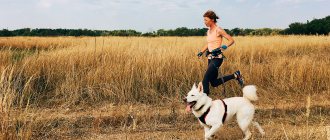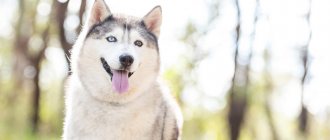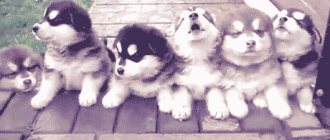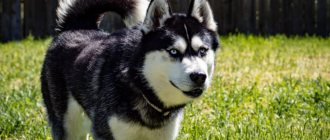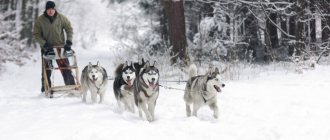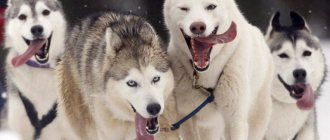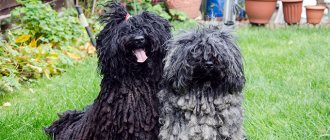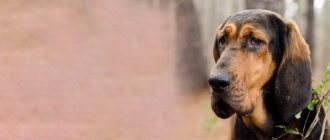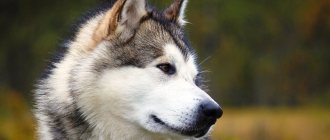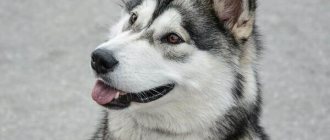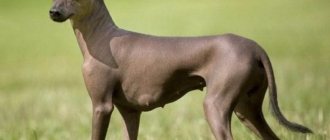Northern dog breeds are those pets that can easily withstand any climatic conditions and especially frost, they are hardy, have thick hair and a good sense of smell. Interestingly, many discoveries in the Arctic were made with the help of northern dogs and sled breeds. Because they were bred specifically for harness work.
It is important to understand that many of the northern dog breeds can be used as pets, but not in the south. After all, due to the thick fur and undercoat, it will be difficult for pets to withstand the heat. Especially if you want to use them as guards and hunters.
The most popular breeds are:
- Siberian Husky;
- Alaskan Malamute;
- Samoyed
Siberian Husky
The Siberian Husky is similar in appearance to the Malamute, but smaller. The breed was bred by breeders; previously they were used by the tribes of the north as hunting and sledding dogs, but with heavy loads. The name comes from the word “eski”, as the tribes of the Arctic were called. The peculiarity of the breed is that they are able to transport heavy loads over long distances. They also have blue eyes, thick fur and weigh up to 30 kg. At the moment the pet is used as a companion and circus dog for shows.
Anatolian Shepherd
This is a serious rock breed, the representatives of which are harsh, hardy, agile and capable of covering long distances. Used in Turkey over 6,000 years ago to guard herds, the Anatolian Shepherd has low energy levels but strong protective qualities. From an early age, she needs to understand who is in charge in the house, and the owner needs to introduce the serious guard to new guests.
Alaskan Husky
The Alaskan Husky is still not included in the FCI classification, but it is considered the ancestor of the Siberian Husky. The breed itself appeared naturally and has much in common with the new northern husky, although it is slightly smaller in size, up to 25 kg. The tribes used the Alaskan husky for hunting and home guarding, and harnessed it to a sled. The coat is thick, gray, white, brown in color.
Alaskan Malamute
The Alaskan Malamute was bred in the north by wild tribes more than three thousand years ago, among its ancestors is the polar wolf. The name comes from the name of the Malemute tribe. They were used for riding in a sled, transporting cargo and protecting homes. The coat is thick with undercoat, color is wolf. The pet requires attention and constant physical training.
Wolfdog
Experimental breed of the Far East regions. Can be used as a harness. Strong, resilient and devoted to people. The first hybrid puppy was born from a male German shepherd and a wild wolf. The wolfdog has the character of a shepherd dog, and its appearance is inherited from that of a wolf. He has strong jaws and a sense of smell 20 times better than that of canines.
Today, these unique mestizos perform security service at state borders and work in the police and army. Nurseries for their breeding are located in Russia and the Czech Republic. Official sale of puppies is prohibited. In all films where the participation of wolves is required, wolf-dogs are filmed. Only a highly qualified dog handler can visually distinguish them from wild predators.
Source
Samoyed dog
Samoyeds are one of the most popular dogs in the world; their appearance resembles a cute bear. The name comes from the Samoyed tribe. Previously used for herding animals, they rarely took part in riding. Only after the start of expeditions to the Arctic, the Samoyed dog began to be used in sled riding. The breed is distinguished by its endurance, activity, and unpretentiousness in the matter of nutrition. The coat is fluffy white, average size – up to 30 kg.
Karelian Bear Dog
Externally, the Karelian Bear Dog has much in common with the Russian Laika, although this breed is much more common. Used for hunting, tracking large animals and home protection. An excellent sense of smell and hunting qualities are genetically determined, but a bear dog needs to be raised and trained constantly. The coat is thick, fluffy, and red in color.
Yakut Laika
The Yakut Laika appeared in the north-east of Russia in the area of “dog rivers”. Pets were used for sledding and hunting large animals. Externally, the Yakut Laika has a medium size, strong paws, thick coat of spotted color (white-black, black-red). The pet easily tolerates any climatic conditions and is quite hardy.
https://youtu.be/ugnGhpr9wLw
Greenland sled dog
The Greenland sled dog is a rather rare breed in our time; it originated in Greenland and was used for sled riding and hunting. Outwardly, it is a strong, hardy, muscular dog. The coat is thick, the color is white, spotted, gray, brown. The peculiarity is that the Greenland sled dog adapts to all living conditions, but it is better not to keep it in an apartment.
Read: Dog breeds for apartments.
Samoyed
The Samoyed is an ancient breed from Asia - it was bred by the Nenets, who lived between the White Sea and the Yenisei. According to one version, the origin of the dog comes from the Nenets Laika. But since all the northern Samoyed tribes had the same type of dog, it can be assumed that they domesticated the white wolf. The oldest representatives of the breed strongly resemble the polar wolf. In addition to riding, Samoyeds took part in hunting, guarded herds and children. They lived in their own houses with their owners.
Samoyeds have a friendly and balanced character. This breed also took part in polar expeditions. You can tell Samoyeds apart from other northerners due to their typical white coat color. This is a white-coated northern sled dog, a very elegant dog with a permanent "smile" on its face.
East Siberian Laika
The East Siberian Laika includes several subspecies of dogs that are still developing and transforming in appearance. Pets appeared on the territory of Russia and were bred by ancient settlements in the eastern part of the country. Externally, these are large dogs weighing up to 50 kg, the coat is thick with undercoat. Laikas were used as sled dogs and hunting dogs. The East Siberian Laika has a heavy temperament, but easily tolerates frost and cold.
The most famous races
Perhaps everyone knows the legendary Iditarod race, which takes place in Alaska. It was first launched in 1973. The dogs must travel 1,868 km (1,161 miles) in eight to fifteen days, from Willow (near Anchorage) to Nome. The Iditarod race was founded in memory of how dogs saved the people of Nome. Medicine for diphtheria was delivered there from Anchorage by sled.
The Yukon Quest is a 1,600-kilometer international sled dog race between Fairbanks (Alaska) and Whitehorse (Canada). The race is held in February and is considered difficult to complete. Sled huskies must run across frozen rivers, 4 mountain ranges in terrain where freezing winds blow and temperatures drop to -50 degrees.
West Siberian Laika
The West Siberian Laika also appeared in the north, in Siberia, but in the western part. These pets are excellent hunters of large animals; they have never been used for transporting goods. Now they can be used as guards for homes. Height – up to 55 cm, weight 30 kg, wool – thick, light, black or brown.
Polar discoveries
Sled dogs were also known in the North during polar expeditions, as dog sleds accompanied polar explorers on their travels. Greenland huskies were part of Roald Amundsen's team that reached the South Pole in 1911. And the traveler Nansen was accompanied by Samoyeds: this team tried to reach the North Pole in 1893. British Jackson-Hamsworth expedition to Franz Josef Land in 1894-97. also accompanied by Samoyeds.
Nordic sled dogs are wonderful friends who deserve our respect. Do you want to buy a northern dog? Contact a reputable nursery and get advice. They are not beginner dogs, they need an experienced handler.
Russian-European Laika
The Russian-European Laika was bred artificially in Russia and is used for hunting and driving large animals, but after special training. Externally, it is a large, powerful dog, up to 60 cm tall. The coat is medium thick, with undercoat, the color is black, white, spotted, brown. Nowadays the Russian-European Laika is used as a guard dog or a companion.
Interestingly, many breeds of huskies were bred artificially after selecting the best native breeds from the vast expanses of Siberia. Therefore, each species has a different size, color and purpose.
Major diseases
Average lifespan of a dog: 10-14 years , although it has been noted that Samoyeds have been living much longer in the last 20 years.
Diseases to which representatives of the breed are susceptible:
- Joint dysplasia. Causes the dog pain and discomfort. Complete cure is possible only after surgery.
- Retinal atrophy. This disease affects the eye's sensitivity to light. Diagnosed at a veterinarian's appointment.
- Samoyeds may be allergic to food components.
- The breed is also susceptible to skin diseases, so it is especially important to care for the coat and check the dog for insects on the skin.
Norwegian Lundehund
The Norwegian Lundehund is now on the verge of extinction; the breed was used for hunting on rocks or in water, now as a companion. The Lundehund is popular in Norway and all northern countries and requires the owner's attention and training. Externally - medium size, massive paws, large erect ears. The coat is thick, there is an undercoat, color is gray, white, red, weight up to 8 kg.
Emthund (Swedish Husky)
The Jemthund or Swedish Husky was bred in Sweden to hunt large animals because the breed is characterized by endurance, a good sense of smell, aggression and persistence. The Emthund will not take root in apartments or city conditions and requires constant training. With proper upbringing, it can act as a guard or companion. Externally, it is a medium-sized dog, gray or wolf in color with muscular paws.
Chinook
The breed was developed at the beginning of the twentieth century. American dog handler, who named her after one of the first representatives. In the selection process, the goal was to select working qualities: speed of movement, adaptation to low temperatures, endurance, athletic build, high intelligence, devotion. They have an unremarkable appearance, but to obtain certain properties of the breed, which is not yet officially recognized, breeders had to make great efforts. In the middle of the last century, Chinooks were at risk of disappearing; their preservation was ensured by the creation of the Association of Fanciers, whose members consider these dogs a national treasure and seek official recognition of the breed. In 2009, the Chinook was declared the state symbol of New Hampshire.
Read List of the best films about dogs - TOP 50
Norwegian Buhund
The Norwegian Buhund originated in Iceland and is related to the Icelandic Sheepdog. Previously used for grazing and corralling animals, now - as a companion. You can keep it in an apartment if you walk it a lot and train it; the qualities of a guard and a hunter are instilled in it from birth. Externally, it is a large breed with muscular paws and thick, light-colored hair.
German Shepherd
The breed gained its popularity after the appearance on screens of Rin Tin Tin, a stray German shepherd puppy found during the First World War and becoming a character in television shows and films.
Representatives of the breed are excellent shepherds, security guards and police officers. They are strong, agile, hardworking, energetic and learn new things quickly.
German Shepherds are prone to hip dysplasia; To avoid these health problems, you should purchase a purebred animal only from trusted breeders.
Lapinporokoira
Lapinporokoira or Lapp Reindeer Dog appeared artificially after the selection of aboriginal hunting dogs of the north. After the ancient tribes began to breed large animals, the reindeer herding dog began to be used for herding and sledding. For some time the breed was on the verge of extinction. Externally, it is of medium size, muscular paws, and thick black fur.
Suomenlapinkoyira (Finnish Lapphund)
Suomenlapinkoyra or Finnish Lapphund appeared in Finland for hunting, herding and corralling animals, and protecting houses from wild animals. Outwardly it resembles a bear up to 20 kg in size, has thick and fluffy fur of gray, white, spotted color. The Lapphund appeared naturally and is considered a descendant of wolves. Can be kept in an apartment, but requires training.
Tibetan mastiff
For some time, Tibetan mastiffs existed exclusively in the Himalayas.
Tibetan Mastiffs feel comfortable in both low and high temperatures. Thick and long two-layer coat protects them from the effects of adverse weather conditions, while in winter the dogs' undercoat is thick and heavy, and by summer it decreases.
Representatives of the breed are predominantly black or brown in color, but there are also red Tibetan mastiffs, which are considered the most expensive (one puppy is estimated at $1.5 million).
Not long ago, a curious incident occurred in a Chinese zoo when they tried to pass off a Tibetan mastiff as an African lion; the spectators were extremely unhappy when they heard the barking of a supposedly representative of the cat family.
Swedish Lapphund (Lapland Spitz)
The Swedish Lapphund or Lapland Spitz was bred in the vastness of Lapland for grazing and corralling livestock, and is now used as a companion or decorative dog. Externally, it has a small size, massive paws, thick and shiny fur, and black color. Can be used as a guard, but with proper training.
It is interesting that most northern dog breeds have a kind, easy-going character, despite the fact that they are used for protection and protection. Such qualities as aggression, anger and complete independence are not inherent in them.
Newfoundland
These wonderful family dogs have low energy levels, but are full of friendliness and caring. Fluffy giants, whose weight can reach 68 kg, are calm and patient.
“Newfoundlands’ thick coats protect them from the icy waters they were originally bred to work in,” DiNardo explains. These Canadian dogs are still used today during water rescue operations; Having a two-layer “fur coat” and a strong body, they also feel great in the mountains.
Newfoundlands have a good quality - they almost never bark. However, future owners of a furry giant should take into account that this pet has profuse salivation.
